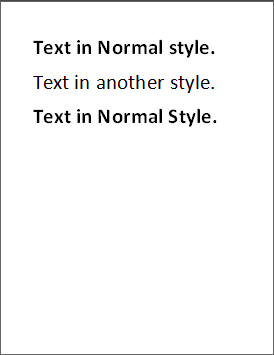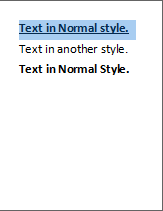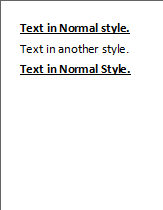autoRedefine (Automatically Merge User Formatting Into Style Definition)
This element specifies whether an application shall automatically modify this style when the contents of an entire paragraph in the document with this style applied are modified, ensuring that although only a single instance of text with this style was modified, that change is stored on the style and therefore propagated to all locations where the style is in use.
If this element is omitted, then formatting shall not automatically be merged back into the style definition.
[Example: Consider a style defined as follows in a WordprocessingML document:
<w:style w:styleId="Normal" … >
<w:name w:val="Normal"/>
<w:autoRedefine/>
<w:rPr>
<w:b/>
</w:rPr>
…
</w:style>
This style specifies via the use of the autoRedefine element that any formatting applied to text which uses this style shall be merged back into the style definition (assuming, of course, that this is a paragraph style).
For example, consider a document which uses the Normal style as defined above:

The first and third paragraphs use the Normal style, and hence have the bold property applied. If an application were to add the underline formatting to the entire first paragraph, as follows:

That property, rather than being saved as direct formatting, shall be used to update the associated Normal style to add this property, specified using the u element (§2.3.2.38).
<w:style w:styleId="Normal" … >
<w:name w:val="Normal"/>
<w:autoRedefine/>
<w:rPr>
<w:b/>
<w:u/>
</w:rPr>
…
</w:style>
Since this property is automatically merged into the style, it would also appear on the third paragraph (note that the step above would normally be automatically modified into the state shown below, and not discrete as shown above).

end example]
|
Parent Elements |
|
style (§2.7.3.17) |
|
Attributes |
Description |
|
val (On/Off Value) |
Specifies a binary value for the property defined by the parent XML element.
A value of on, 1, or true specifies that the property shall be explicitly applied. This is the default value for this attribute, and is implied when the parent element is present, but this attribute is omitted.
A value of off, 0, or false specifies that the property shall be explicitly turned off.
[Example: For example, consider the following on/off property:
<w:… w:val="off"/>
The val attribute explicitly declares that the property is turned off. end example]
The possible values for this attribute are defined by the ST_OnOff simple type (§2.18.67). |
The following XML Schema fragment defines the contents of this element:
<complexType name="CT_OnOff">
<attribute name="val" type="ST_OnOff"/>
</complexType>